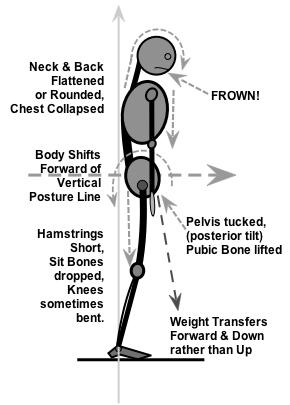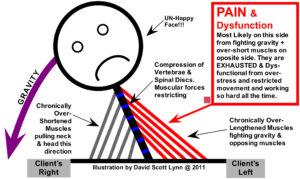What Are Structural Balancing
& Postural Evaluation?
Structural Balancing & Postural Evaluation (or Assessment)
are very different, yet closely related processes.
There are many different approaches and versions of these processes in massage & bodywork, as well as physical or occupational therapies. We will herein describe the specific process developed, utilized, and taught by Kyle C. Wright’s Schools of Advanced Bodywork.
Structural Balancing:

Structural Balancing is an Art & Science … While it is based on many sound, time-tested, medically proven principles, there are so many factors operating in the human body it takes some experience to develop the “sense” or “art” of seeing and figuring out what is going on in the human body.
The first thing in a therapy session is figuring out what you are going to do. At the Schools of Advanced Bodywork, they do not just show you a bunch of techniques to do and hope they work. This is NOT what is called in the trade a “Poke & Hope” process where you just press on things and hope it helps.
You are taught to more precisely track down what the most likely elements of a Client’s soft tissue issues are, determine a proper sequence of which muscles to work and when, then proceed As you proceed, you observe the Clients responses and listen to their feedback, and monitor as to whether you are on the Right Track or not.
Even the Best of us do on to always get it right the first time. In the more complex clients, it can be a lot like “detective work.” That’s because there are, in many cases, many possibilities of what could be causing a Client’s issues.
Some of that could be because the Client forgets to tell you about a significant accident they had. Or they thought it was so long ago it was not important. …
But EVERYTHING is Important!
So here is a description of the Elements of what I call BIO-Structural Analysis. The “BIO-” part is because you’re not just examining the tissues in the Client’s body. You are inquiring about many aspects of their health history. … I’ll get to that in a moment.
Yet because this work is based on sound, medically researched principles, you have a VERY high success rate at getting to the root cause of what is happening to cause a Client’s complaints, be they pain or dysfunction.
The “Medically Proven Principles” are the …
• Anatomical Descriptions of the many & various parts of the body.
• Rules of How Those Parts Interact with each other to stabilize, protect, and move the body in space.
• Neuro-Control Systems, the Brain, Central Nerve System, and Peripheral Nerves that receive sensory information and send out motor control commands to the muscles and organs.
• Physical Sciences such as gravitational forces, hydrostatic (water) pressures, how structures work, how & why things “stand up” instead of fall down, and so on.
Then we have the Client or Patient Interview …
Here, we are delving into the Client’s history, especially any traumatic accidents or injuries they might have had. The body reacts to such events in sometimes VERY strong fashion, and those reactions are often embedded in their Psycho-Neuro-Musculo-Fascial ( PNMF) system.
The “psycho-“ part refers only to the fact that the human mind is intimately involved in many of the actions of the body. When you lift a weight or do a sit-up, you are using your mind to volitionally intimate and control the action. So if a former weight lifter overstressed their muscles and is experiencing pain later in life, addressing the “cause” of the pain is more effective and efficient if the mind is engaged in the process of luring how to let go of that tension.
Relaxation or DE-Contraction of muscles is far better accomplished if the person is consciously engaging the mind in the process of Feeling & Relaxing their musculo-fascial units. Which as I said, includes the mind and nerves (the PNMF).
Their aches & pains, their lost range of motion, their loss of strength & endurance, and loss of balance & coordination, are often the result of hyper-facilitation of that PNMF system.
Some people call it “muscle memory,” because it seems “stuck” in the muscles. Yet that memory is really “stored” in the brain, nerve system, and musculo-fascial tissues. Those tissues all work together to retain the protective or stabilizing actions that occurred in the various situations of their lives.
Another Factor in the Patient Interview is their “Health History.” This includes all the exercises & stretches they did — or did NOT do — throughout their lives. For example, if a youngster did five years of classical ballet at a long age, then stopped doing it, those patterns of action will most likely stay “stuck” in their PNMF system for LIFE!
Same with a football player. The various stresses, strains & impacts upon the body are stored as well, maybe even more so, as there was often more trauma associated with the activity.
BIO-Structural Analysis
It has often been said in orthopedic (medical) and osteopathic (the manual school osteopathy) literature that much of the success in the physical aspects of life has to do with learning how to deal effectively and efficiently with the forces of gravity upon the human body. It is also said, to a lesser extent and less orthodox literature, that much mental and emotional health is at least somewhat dependent on a proper physical relationship to gravity.

One of the many functions of effective bodywork is helping a client discover how to recover this proper and natural relationship which is usually lost early in life, including removing many of the neuromuscular, myofascial and musculoskeletal conditionings and habits that obstruct the operation of the body in the ever present field of gravity.
Most little children have great posture and fluid movement, with NO training, by way of natural forces that are built into the body by nature at birth. A lifetime of accumulating tensions, stresses and negative habits interfere with these natural forces. Although some children have lost their unconscious experiment with gravity by a very young age.
Although outside the scope of this text, structural analysis refers to the in-depth application of physics and geometry to observing and understanding how structures work; i.e., what makes something stand upright?
For example, in the human body, internal forces of muscular pull, leverage of the bones, and hydrostatic pressure interact with the external forces of gravity or other pressures upon the body. The quality of this interaction, in great part, determines our ability to maintain effortless great posture, energetic, fluid movement, and a proper physical and mental attitude.
Learning to see these relationships builds the foundation for effective postural assessment.
Postural Evaluation (or Assessment):
Postural assessment takes the understanding of these [various] structural forces and applies them to discovering which pulls of muscular tension are distorting or otherwise interfering with posture and movement. There are, in our model, essentially four stages of postural assessment.
Understanding Physical Forces such as Vector Lines of Impact & Energy and Repetitive Actions & Stresses experienced by your Clients during day-to-day activities as well as stress, injury & trauma give you Greater, more Relevant Insights into better Treatment Strategies. [Quote from the website of DavidScottLynn.com]
To See More on Postural Assessment, Please obtain Kyle C. Wright’s textbook, Structural Balancing: A Clinical Approach, co-authored by David Scott Lynn.
Myo-Structural Bodywork:
Please See the Webpage: Edge-Touch Manual Technique — No Pain, MORE Gain
David Scott Lynn,
founder of DSL Edgework.
His therapy work is part of the SAB’s Core Curriculum
(SABs: Schools of Advanced Bodywork.)

